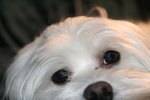Things You'll Need
Soft dog food
Dog bowl
Spoon
Calorie supplement
Large syringe
Toothbrush
Towel
Owning a dog with a physical deformity or traumatic injury can be a daunting task. Feeding, cleaning up after, even routine tasks such as walking and grooming are much more difficult when your beloved pet has a handicap. Feeding a dog with no lower jaw can be an especially challenging duty, although seeing your canine companion healthy and happy is well worth all your time and effort.
Speak with your vet regarding your dog’s diet. Without a functioning lower jaw, it will be nearly impossible for him to eat from a bowl like a normal dog, so your vet will advise you on the best way to feed him. Your dog’s meals will need to be broken down into small sessions throughout the day to make sure he is getting enough nutrition, so plan your schedule accordingly.
Choose a nutritionally-balanced, soft dog food and place the proper portion for your dog in the bowl. He may not be able to eat from the bowl himself, but he will still associate the sight of his bowl with feeding time. Stir it with your spoon, adding a dose of calorie supplement to the dog food. Supplements such as NutriCal, are full of vitamins and nutrients that your dog may not get from a straight canned diet, and will help him maintain an appropriate weight and energy level.
Offer your dog a small amount from the spoon, allowing him to investigate the food. He should open his mouth and attempt to take a bite, although you may have to place the food on the back of his tongue in order for him to get it. If he does not readily open his mouth, gently place the spoon inside his mouth and let the food sit on his tongue. It may take three or four force-fed bites before he realizes he can eat off the spoon himself.
Continue feeding him small bites until he seems full. If the food is sticking in his mouth, gently rinse his tongue to remove the stuck food. Fill your syringe with warm water and slowly squirt a small amount onto his tongue, allowing him to move it around and loosen the food. He may not want to eat more than a few bites in a single feeding, so store the remaining food in the refrigerator and try again later if he becomes disinterested.
Brush your dog’s teeth after he’s finished eating. A diet of exclusively soft dog food can quickly cause tooth decay, so brushing is vital to optimal tooth and gum health. Dampen your brush in water and gently brush each of his teeth, taking care to remove any stray bits of food. Rinse his mouth again with the syringe, using the towel to wipe off any rinse water or food that may have fallen on his coat during feeding.
Tips
Follow your vet’s feeding instructions carefully to prevent malnutrition. It may be tempting to feed your dog table scraps, but human food is not well-balanced or nutritionally sound for your pet, and can cause more harm than good.
Warnings
Never punish your dog for not wanting to eat. It can be a difficult adjustment for him to have to be fed from a spoon, so be patient and allow him plenty of time to learn his new feeding routine.
References
Writer Bio
Louise Lawson has been a published author and editor for more than 10 years. Lawson specializes in pet and food-related articles, utilizing her 15 years as a sous chef and as a dog breeder, handler and trainer to produce pieces for online and print publications.





